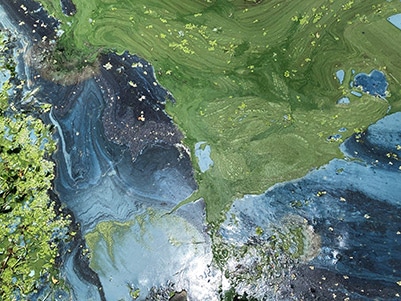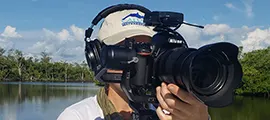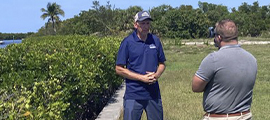Issue:
Harmful Algal Blooms

Blue-green Algae (Cyanobacteria)
Cyanobacteria is one of the oldest types of lifeforms on Earth and is found primarily in freshwater systems. There are thousands of species of cyanobacteria and many are known to produce a variety of toxins.
Cyanobacteria is a photosynthetic microorganism that processes sunlight, nitrogen and phosphorous to live. They can regualate their position in the water column for optimal light and thrive in warm, nutrient-rich fresh or brackish water with low turbulence.
Microcystis and Anabaena are two of the most common cyanobacteria found in estuarine systems today. These bacteria are known to produce cyanotoxins dangerous to humans and animals. Microcystin and Anatoxin are classes of hepatoxin and neurotoxin, affecting the liver and brain, respectively.
Human and animal exposure to Cyantoxins comes in three primary forms of contact:
- Dermal contact
- Inhalation or aspiration from aerosolized surface water
- Ingestion
Harmful algal blooms have severe impacts on human health, aquatic ecosystems and our economy.
Red Tide (Karenia brevis)
Red tide is a marine dinoflagellate found in saltwater, and has been known to inhabit the Gulf of Mexico throughout recorded history. Red tide blooms have been increasing in scope and intensity within the last 30 years. Red tide has also occurred throughout the Gulf and Atlantic Coast, reaching as far as North Carolina.
Karenia brevis can utilize at least 12 different forms of nutrients and also consume other single cell organisms for food. They are capable of motion and directed swimming allowing them greater access to nutrients.
Red Tide produces brevatoxins which can be deadly to many sea animals and often causes acute respiratory symptoms in humans. Aerosolized health effects include irritation of the eyes, nose, throat and lungs and exacerbating occurrences of respiratory distress, bronchitis, asthma and pneumonia. Brevatoxin can also have a serious impact on the marine food-chain, contributing to shellfish poisoning and gastrointestinal disorders.

Take Action
Contact Your State Legislators
Calusa Waterkeeper calls on citizens and stakeholders to urge elected officials and responsible agencies to take the following ten actions:
The toxic blue-green algae (cyanobacteria) often stretching from Lake Okeechobee to our west coast is the result of decades of failed water policy implementation. A perfect storm of lax enforcement and under-funding at the local, state and national levels has culminated in the historic harmful algae blooms (HABs) that plagued our region in 2018 (and so many other years).
If political leaders fail to take action, history is doomed to repeat itself year after year, causing catastrophic harm to our ecosystem and our economy.
The science is clear on what needs to be done.
What has been lacking is the political will to enact the regulation and legislation required to begin to reverse these problems. We look to you, as informed citizens, to proactively communicate your water quality concerns to newly elected officials. It will take a groundswell of voices if we are to affect change in Tallahassee during this coming legislative session.
Find Your Legislators
Related News Stories
Harmful Algal Blooms
Initial SWFL Study Finds Water & Air Pollutants could cause grave Brain Disease
A first-of-its-kind field study of Southwest Florida air and water didn’t find widespread cyanobacteria toxins however, it did find several neurotoxins as well as three forms of BMAA, a neurotoxin linked to grave brain diseases.
Collaborative Research on Airborne Toxins from Harmful Algal Blooms in Southwest Florida
Calusa Waterkeeper and Wyoming-based Brain Chemistry Labs collaborate on a groundbreaking device to research airborne toxins from harmful algal blooms utilizing the most sensitive technology available for detecting harmful algal bloom (HAB) toxins,
Study Shows Nitrogen Flows Systematically Intensify Red Tide Blooms
A new University of Florida study with two nonprofit research partners shows clear ties between nitrogen from human activities and the longevity and severity of the saltwater harmful algal blooms as published in the academic journal Science of the Total Environment.
Warm Temps Could Fuel Storms this Summer Resulting in Future Algae Blooms
Gulf of Mexico and Lake Okeechobee water temperatures are warm for this time of year, and those warm waters could lead to a myriad of problems, from blue-green algae blooms to feeding tropical storms and hurricanes that could lead to bloom conditions in the summer of 2023.
Algae found floating in Cape Coral canals
John Cassani is the Calusa Waterkeeper and says there were multiple factors leading to the green algae. These include rain, water movement and warm water temperature. But the dominant force is runoff.
Florida Urged to Set Standards Critical to Protecting People & Wildlife From Harmful Toxins
Conservation groups sent a letter today urging Florida officials to set water-quality standards for the harmful toxins in algal blooms that threaten the health of the state’s residents and wildlife. The request comes after the FDEP announced it would not set legal limits on the cyanotoxins that make the blooms so harmful.
Make a Donation
Get Notified
Priority Issues
Harmful Algal Blooms
Cyanobacteria & Red Tide
Cyanobacteria (blue-green algae) and Karenia brevis (red tide) have been making major impacts on Southwest Florida.
Lake Okeechobee Discharges
Revise System Operating Manual
The Caloosahatchee River often suffers from too much freshwater in the wet season, and not enough freshwater in the dry season.
Cape Coral Spreader Canals
Nutrient & Sediment Loading
The City of Cape Coral is working to remove large storm-water barriers to make recreational boating more convenient.
Bacteria Monitoring
Fecal Indicator Bacteria
Calusa Waterkeeper has been at the forefront of monitoring this Fort Myers tributary for fecal bacteria indicators.




































